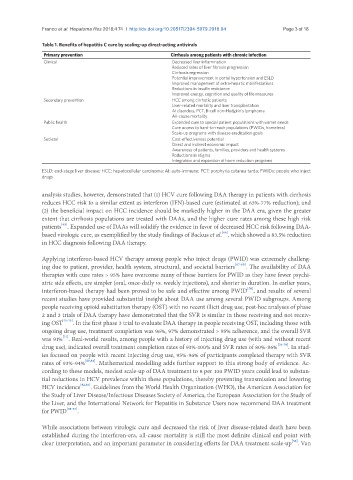Page 829 - Read Online
P. 829
Franco et al. Hepatoma Res 2018;4:74 I http://dx.doi.org/10.20517/2394-5079.2018.94 Page 3 of 18
Table 1. Benefits of hepatitis C cure by scaling-up direct-acting antivirals
Primary prevention Cirrhosis among patients with chronic infection
Clinical Decreased liver inflammation
Reduced rates of liver fibrosis progression
Cirrhosis regression
Potential improvement in portal hypertension and ESLD
Improved management of extra-hepatic manifestations
Reductions in insulin resistance
Improved energy, cognition and quality of life measures
Secondary prevention HCC among cirrhotic patients
Liver-related mortality and liver transplantation
AI disorders, PCT, B-cell non-Hodgkin’s lymphoma
All-cause mortality
Public health Expanded cure to special patient populations with unmet needs
Cure access to hard-to-reach populations (PWIDs, homeless)
Scale-up programs with disease eradication goals
Societal Cost-effectiveness potential
Direct and indirect economic impact
Awareness of patients, families, providers and health systems
Reductions in stigma
Integration and expansion of harm reduction programs
ESLD: end-stage liver disease; HCC: hepatocellular carcinoma; AI: auto-immune; PCT: porphyria cutanea tarda; PWIDs: people who inject
drugs
analysis studies, however, demonstrated that (1) HCV cure following DAA therapy in patients with cirrhosis
reduces HCC risk to a similar extent as interferon (IFN)-based cure (estimated at 63%-77% reduction); and
(2) the beneficial impact on HCC incidence should be markedly higher in the DAA era, given the greater
extent that cirrhosis populations are treated with DAAs, and the higher cure rates among these high risk
[65]
patients . Expanded use of DAAs will solidify the evidence in favor of decreased HCC risk following DAA-
based virologic cure, as exemplified by the study findings of Backus et al. , which showed a 83.5% reduction
[66]
in HCC diagnosis following DAA therapy.
Applying interferon-based HCV therapy among people who inject drugs (PWID) was extremely challeng-
ing due to patient, provider, health system, structural, and societal barriers [67-69] . The availability of DAA
therapies with cure rates > 95% have overcome many of these barriers for PWID as they have fewer psychi-
atric side effects, are simpler (oral, once-daily vs. weekly injections), and shorter in duration. In earlier years,
[70]
interferon-based therapy had been proved to be safe and effective among PWID , and results of several
recent studies have provided substantial insight about DAA use among several PWID subgroups. Among
people receiving opioid substitution therapy (OST) with no recent illicit drug use, post-hoc analyses of phase
2 and 3 trials of DAA therapy have demonstrated that the SVR is similar in those receiving and not receiv-
ing OST [71-75] . In the first phase 3 trial to evaluate DAA therapy in people receiving OST, including those with
ongoing drug use, treatment completion was 96%, 97% demonstrated > 95% adherence, and the overall SVR
[71]
was 91% . Real-world results, among people with a history of injecting drug use (with and without recent
drug use), indicated overall treatment completion rates of 93%-100% and SVR rates of 80%-96% [76-79] . In stud-
ies focused on people with recent injecting drug use, 95%-96% of participants completed therapy with SVR
rates of 93%-94% [80,81] . Mathematical modelling adds further support to this strong body of evidence. Ac-
cording to these models, modest scale-up of DAA treatment to 8 per 100 PWID years could lead to substan-
tial reductions in HCV prevalence within these populations, thereby preventing transmission and lowering
HCV incidence [82,83] . Guidelines from the World Health Organization (WHO), the American Association for
the Study of Liver Disease/Infectious Diseases Society of America, the European Association for the Study of
the Liver, and the International Network for Hepatitis in Substance Users now recommend DAA treatment
for PWID [84-87] .
While associations between virologic cure and decreased the risk of liver disease-related death have been
established during the interferon-era, all-cause mortality is still the most definite clinical end point with
[50]
clear interpretation, and an important parameter in considering efforts for DAA treatment scale-up . Van

